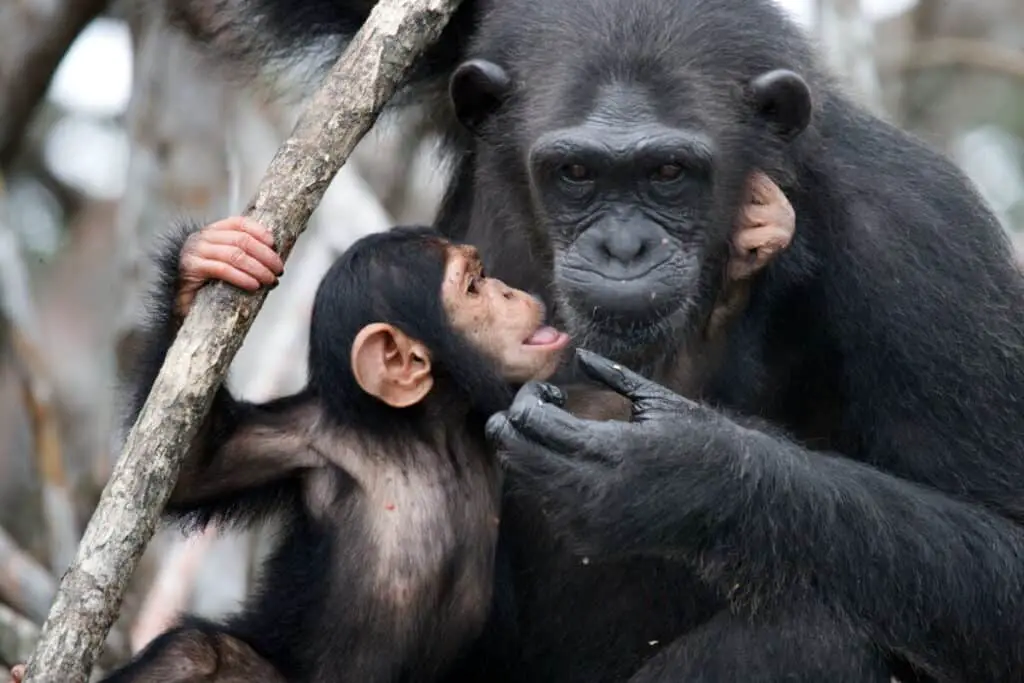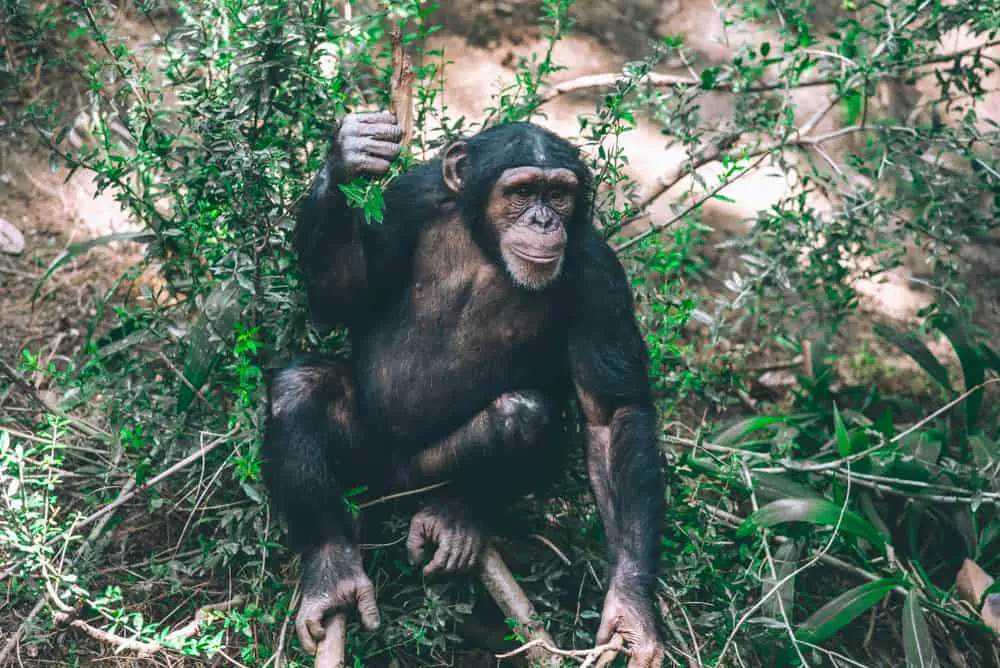Chimpanzees, one of our closest living relatives, are known for their intelligence and complex social behaviors. But what about their senses? How do they compare to ours as humans? Understanding the sensory abilities of chimpanzees can provide insights into their behavior and evolutionary history.
Chimpanzees have highly developed vision, acute hearing, and critical sense of smell. They have five times more olfactory receptors than humans and specialized receptors in fingertips. Chimpanzees communicate through vocalizations, echolocation, pheromones, touch, and recognition of individual voices. Chimpanzees have a diverse diet including fruits, leaves, insects, and meat, and use remarkable dexterity when using tools.
In this article, we will explore the different senses of chimpanzees in detail, including vision, hearing, smell, taste, touch, and spatial awareness. We will examine how these senses contribute to their survival and adaptation in their natural environment. Additionally, we will compare the sensory abilities of chimpanzees to those of humans to gain a better understanding of our shared ancestry and divergence over time.

The Importance of Senses for Chimpanzees
The sensory capabilities of chimpanzees have been a crucial factor in their evolution and survival as they rely heavily on their senses for communication, navigation, foraging and protection against predators. Chimpanzees possess a highly developed sense of vision that allows them to distinguish between different colors and shapes, including the ability to recognize faces. This is particularly important for social interactions as it enables them to identify individuals within their group and differentiate between friends and foes.
In addition to vision, chimpanzees also have an acute sense of hearing that enables them to communicate with each other through vocalizations such as screams, grunts and barks. Their sense of smell is another critical tool in their survival arsenal as it helps them detect food sources, identify potential dangers and even recognize members of their own family. The importance of these senses cannot be overstated as they are essential for the daily lives of chimpanzees in the wild and have played a significant role in shaping their evolutionary history.
Vision: Seeing the World in Color
Through the analysis of their retinas, it has been concluded that chimpanzees possess three types of color photoreceptors, allowing them to see the world in a similar way to humans. However, color vision adaptations in chimpanzees also have limitations in color perception. In particular, they are not able to distinguish between red and green colors as well as humans do.
To illustrate this point further, we can compare the spectral sensitivities of human and chimpanzee photopigments. The table below shows the peak wavelengths at which each type of photopigment absorbs light. As we can see from the table, human photopigments are sensitive to a wider range of wavelengths than those of chimpanzees. This means that humans are better able to differentiate between different shades of colors within the same spectrum compared to chimpanzees. Nonetheless, this does not mean that chimpanzees have poor color vision altogether; rather it highlights an important limitation in their ability to perceive certain colors accurately.
| Human | Chimpanzee | |
|---|---|---|
| L (red) | 560 nm | 534 nm |
| M (green) | 530 nm | 558 nm |
| S (blue) | 420 nm | 430 nm |
Hearing: Acute Auditory Abilities
Acoustic sensitivity is a key aspect of chimpanzees’ perceptual abilities. Chimpanzee hearing is highly acute, and they can detect sounds at frequencies ranging from 0.3 to 4 kHz, which is much wider than the range of human hearing. In addition to their ability to hear a wide range of frequencies, chimpanzees have been found to use sound as a means of communication. They produce different vocalizations for different purposes such as warning calls when they perceive danger or screams when in distress.
Chimpanzees also use echolocation as a way of locating food sources in their environment. They emit high-pitched sounds that bounce off objects in their surroundings and return to them as echoes. By analyzing the time it takes for the echo to return, chimpanzees are able to determine the distance and direction of an object or prey even in complete darkness or dense vegetation. Furthermore, studies have shown that chimpanzees are capable of recognizing individual voices and can even distinguish between the calls made by members within their own group versus those made by outsiders. Overall, these findings highlight the remarkable auditory capabilities of chimpanzees and shed light on how important acoustic perception is for their survival in the wild.
Chimpanzees’ Predators Exposed: A Fight for Survival
Smell: A Powerful Sense for Chimpanzees
Smell plays a significant role in the lives of chimpanzees, as they rely on this powerful sense to navigate their environment and communicate with members of their group. Chimpanzees have been found to possess an extraordinary olfactory ability, capable of detecting scents that are imperceptible to humans. Researchers have identified that chimpanzees possess approximately five times more olfactory receptors than humans, which suggests that their sense of smell is much more acute.
Chimpanzee olfactory abilities can be attributed to the importance of scent communication within their social structure. Chimpanzees use a variety of different odors to communicate with other members of their group, including pheromones secreted by various glands in their body. They also use urine and feces as means of leaving scent marks on trees or the ground, which help them establish territory boundaries and track other individuals’ movement patterns. The table below summarizes some examples of how chimpanzees utilize their impressive sense of smell for survival purposes.
| Scent | Purpose |
|---|---|
| Pheromones | Communicate status and reproductive condition among females |
| Urine Marking | Establish territorial boundaries and identify individuals |
| Feces Smearing | Communicate presence and location; deter predators |
| Food Detection | Locate food sources through scent trails |
| Predator Detection | Detect potential danger through smelling others’ fear response |
Overall, it is evident that smell plays a crucial role in the lives of chimpanzees and serves as an essential tool for communication, navigation, and survival in their natural habitat. Their exceptional olfactory abilities allow them to detect subtle changes in scents that would go unnoticed by humans, making them highly efficient at identifying potential threats or opportunities for food acquisition.
Taste: What Do Chimpanzees Like to Eat?
The gustatory preferences of chimpanzees are shaped by a variety of factors, including ecological constraints and social learning. Research has shown that chimpanzees have a highly diverse diet that includes fruits, leaves, insects, and even meat. Although chimpanzees have been observed to eat hundreds of different plant species, they tend to prefer ripe fruits over other types of food. This preference for fruit is likely due to its high sugar content and caloric value.
Additionally, chimpanzee taste preferences may also be influenced by dietary adaptations. For instance, some studies suggest that their ability to detect bitter flavors may have evolved as a defense mechanism against toxic plants. On the other hand, their preference for sweet tastes could be related to their need for quick energy sources in the form of simple sugars found in fruits. Overall, while there is still much we do not know about chimpanzee taste preferences and how they shape their diets, it is clear that these primates have an incredibly sophisticated sense of taste that plays an important role in their survival.

Touch: Sensitivity and Tactile Perception
Previously, we explored the taste preferences of chimpanzees and their dietary habits. However, chimpanzees rely on more than just taste to navigate their environment. Their sense of touch is another crucial component that allows them to interact with their surroundings.
Chimpanzees possess an impressive sensitivity to touch, which enables them to distinguish between textures and temperatures. They have specialized receptors in their fingertips called Meissner’s corpuscles that are responsible for detecting light touches and vibrations. Additionally, they possess Pacinian corpuscles that detect pressure changes, allowing them to feel objects in their grasp and gauge the amount of force needed for manipulation. This heightened sensitivity plays a significant role in social interactions as well; chimpanzees often use touch as a form of communication with each other, from grooming behaviors to comfort seeking.
To further understand the complexity of chimpanzee tactile perception, let us delve into the following nested bullet points:
- The role of hair: Chimpanzee hair serves as both an insulator against environmental extremes and a sensory organ capable of detecting movement and texture.
- Tool use: Chimpanzees display remarkable dexterity when using tools such as sticks or rocks for various tasks. The tactile feedback provided by these implements aids in their ability to manipulate objects effectively.
- Developmental stages: Like humans, chimpanzees undergo developmental changes in tactile perception throughout infancy and adolescence that are influenced by environmental factors such as maternal care and socialization experiences.
Spatial Awareness: Navigating the Environment
Chimpanzees’ spatial awareness is a crucial aspect of their ability to navigate and interact with their environment. Chimpanzee spatial cognition allows them to understand the layout of their surroundings, determine their position within that space, and find food sources. Their wayfinding abilities are particularly impressive, as they are able to remember landmarks and paths through complex terrains even after extended periods of time.
Studies have shown that chimpanzees use a variety of strategies to navigate their environment. They may use visual cues such as landmarks or patterns on the ground, or rely on memory and mental mapping skills to create cognitive maps of their surroundings. They also demonstrate an understanding of social hierarchies within their group, which can influence how they move through space. Overall, chimpanzees’ spatial awareness is a critical component of their survival in the wild, allowing them to efficiently locate resources and avoid potential dangers in a constantly changing environment.
Comparing Chimpanzee and Human Senses
Humans and chimpanzees exhibit notable differences in their perception of the world around them, which can be attributed to the evolution of sensory perception. While humans are known for their exceptional vision, with a wider range of color sensitivity and better visual acuity than any other primate, chimpanzees have evolved to rely more on smell and touch. This is because they inhabit dense forests where visibility is limited, and thus must rely on other senses to navigate their environment.
In addition to differences in vision, there are also notable variations between human and chimpanzee hearing abilities. Humans have a broader frequency range for hearing than chimpanzees, but it has been suggested that chimpanzees may be able to distinguish subtle differences in pitch that humans cannot detect. Furthermore, studies have shown that chimpanzees possess an acute sense of touch compared to humans and can use this ability for fine motor tasks such as tool use. Overall, while there are significant differences between the sensory perceptions of humans and chimpanzees due to evolutionary adaptations, both species have developed distinct advantages in order to survive in their respective environments.
Conclusion
In conclusion, chimpanzees possess highly developed sensory abilities that are crucial for their survival in the wild. Their vision allows them to see in color and identify patterns, while their acute auditory senses enable them to detect subtle sounds from afar. The sense of smell is especially important for these primates as it plays a significant role in communication, mating rituals, and identifying predators.
Chimpanzees also have a well-developed sense of taste and are known to be selective eaters. Their sensitivity to touch and tactile perception enables them to manipulate objects with precision and navigate their environment with ease. Furthermore, spatial awareness is another essential sense that helps chimpanzees navigate through complex environments such as forests.
While there are similarities between human and chimpanzee senses, the latter have evolved to suit their unique needs as primates living in the wild. Understanding the sensory abilities of chimpanzees can shed light on how they interact with their environment and provide valuable insights into primate cognition.
